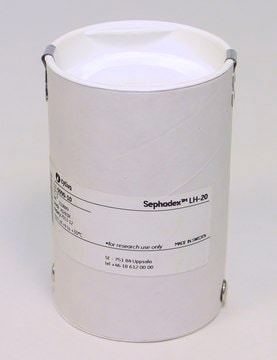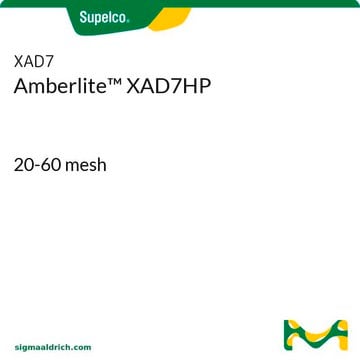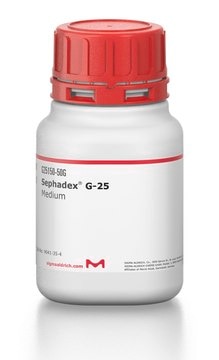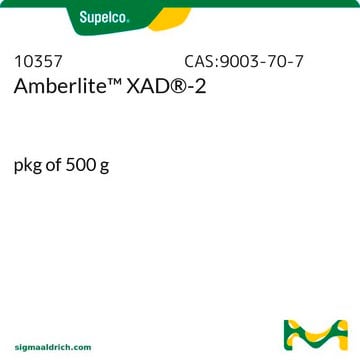LH20100
Sephadex® LH-20 Size Exclusion Resin
140-550 mesh
Synonym(s):
Lipophilic Sephadex®
Sign Into View Organizational & Contract Pricing
All Photos(1)
About This Item
UNSPSC Code:
13111000
NACRES:
NB.21
Recommended Products
Product Name
Sephadex® LH-20,
form
slurry
Quality Level
technique(s)
LPLC: suitable
matrix
Agarose
matrix active group
polymer
swelling
1 g swells to 4 mL (water, methanol)
bead size
25-100 μm
operating pH range
2-13
separation technique
size exclusion (SEC)
storage temp.
room temp
Related Categories
Application
Sephadex® LH-20 is a crosslinked dextran-based resin used with organic solvent mobile phases for gel permeation, normal phase partition, and adsorption chromatography of lipids, steroids, fatty acids, hormones, vitamins, etc. It is also used in gel filtration chromatography, protein chromatography, gel filtration media, resins and separation media.
Sephadex® LH-20 has been used to isolate bioactive polyphenolic content from blackberry genotypes and tryptophan from the aqueous extract of lotus rhizomes.
Sephadex® LH-20 has been used to isolate bioactive polyphenolic content from blackberry genotypes and tryptophan from the aqueous extract of lotus rhizomes.
Legal Information
Sephadex is a registered trademark of Cytiva
replaced by
Product No.
Description
Pricing
Storage Class Code
11 - Combustible Solids
WGK
WGK 3
Flash Point(F)
Not applicable
Flash Point(C)
Not applicable
Personal Protective Equipment
dust mask type N95 (US), Eyeshields, Gloves
Choose from one of the most recent versions:
Certificates of Analysis (COA)
Lot/Batch Number
Don't see the Right Version?
If you require a particular version, you can look up a specific certificate by the Lot or Batch number.
Already Own This Product?
Find documentation for the products that you have recently purchased in the Document Library.
Customers Also Viewed
P Kolodziejczyk et al.
Free radical biology & medicine, 5(1), 13-25 (1988-01-01)
Ambient temperature incubation of the anticancer agent mitoxantrone with horseradish peroxidase and hydrogen peroxide converts it into a hexahydronaphtho[2,3-f]quinoxaline-7,12-dione in which one side chain has cyclized to the chromophore. The structure of this cyclic metabolite was secured by independent synthesis.
A Cahouet et al.
International journal of pharmaceutics, 242(1-2), 367-371 (2002-08-15)
The aim of the present work was to study the biodistribution of a radiolabeled lipidic nanocapsule formulation after intravenous administration in rat by scintigraphy and gamma counting. This formulation is expected to be used as anticancer agent delivery devices and
A K Tandon et al.
Cancer research, 46(7), 3375-3377 (1986-07-01)
We described recently a modified charcoal-gelatin (MCG) assay for measuring progesterone receptor activity in low-protein cytosols. We showed that pre-mixing of gelatin with sample cytosols (final gelatin concentration 0.1%) and removal of unbound steroid by a 1% charcoal suspension with
Y Jiang et al.
International journal of food sciences and nutrition, 61(4), 346-356 (2010-05-15)
Various vegetables were investigated for antioxidant activities in two assays, namely, inhibition of lysis of erythrocytes induced by peroxyl radicals and inhibition of lipid peroxidation. The lotus (Nelumbo nucifera Gaertn) rhizome showed the strongest antioxidant activity in both assays. The
Beatriz Pereira Moreno et al.
Chemistry & biodiversity, 17(3), e1900694-e1900694 (2020-02-06)
Studies of the phytotoxic effects between plants can be a crucial tool in the discovery of innovative compounds with herbicide potential. In this sense, we can highlight ruzigrass (Urochloa ruziziensis), which is traditionally used in the crop rotation system in
Our team of scientists has experience in all areas of research including Life Science, Material Science, Chemical Synthesis, Chromatography, Analytical and many others.
Contact Technical Service









